DESIGN NAME:
Translucence
PRIMARY FUNCTION:
Pendant Light
INSPIRATION:
Iestyn Davies is both a glassmaker and lighting designer; inspiration came from wishing to reinstate the traditional craft-based technique of hot glass to a bespoke contemporary process rather than that of mass production. The goal was ultimately to combine this singular material with the emerging LED cob technology, even though the light source was hidden from view:to explore the unique properties of variable thickness optical glass and experiment with the interplay between two interactive glass surfaces, natural and integral light and ultimately explore a luxury aesthetic.
UNIQUE PROPERTIES / PROJECT DESCRIPTION:
Each individual pendant light can be viewed as a unique bespoke object, each subtly different from the next. The laser-cut acrylic detail to the centre creates focus and further enhances the light source; emulating the same material properties of the main body yet offering precision, detail, and durability; not properties readily associated with glass on such a small scale. There are three variables of the intricate central section and the pendant has been designed to operate as a stand-alone design or within a multi-array feature chandelier. Future design considerations will include a wall light and a desk top version.
OPERATION / FLOW / INTERACTION:
The LED cob light is rated at 50,000 hours and can be changed by removing the rear locknut and drawing out the assembly from the front. The cob unit can be disconnected via two screw terminals and another unit be introduced by reversing this process.
PROJECT DURATION AND LOCATION:
This project started in June 2020 in London, with a series of glassmaking trials and lighting tests. It then moved to the Contemporary Chandeliers’ main studio in Shropshire, in August 2020, as part of an ongoing investigation into sculptural glass components.
FITS BEST INTO CATEGORY:
Lighting Products and Fixtures Design
|
PRODUCTION / REALIZATION TECHNOLOGY:
Firstly, we experimented with how to package the LED cob tape, creating the core of the design. We produced countless acrylic laser-cut variations whilst exploring numerous hot glass forms, at the furnace side, using different optic moulds, reheats, shapes and proportions. We then explored different shapes and thicknesses of the delicate laser cut centres that sit immediately around the light source. All components were then brought together and, several iterations and months later, we were finally satisfied that we had captured the required aesthetic.
SPECIFICATIONS / TECHNICAL PROPERTIES:
Small - w: 120mm x d: 70mm x h: 120mm - approximately 100 lumens.
Medium - w: 170mm x d: 95mm x h: 170mm - approximately 100 lumens.
Large - w: 220mm x d: 110mm x h: 220mm - approximately 130 lumens.
Available in 2700K, 3000K or 5000K.
Materials: Glass (hand blown from 0% lead crystal,
Acrylic (housing for cob tape) LED cob tape
Mild steel threaded bar 2 x decorative lock-nut
Decorative cast acrylic laser-cut detail to centre Mirrored acrylic centre
Switch: customisable (via 12volt driver from mains supply) and mains dimmable.
TAGS:
Light, Pendant, Chandelier, glass, optical, aesthetic.
RESEARCH ABSTRACT:
We wished to design a luminaire around our own dedicated low energy light source. We generally prefer to hide the light source wherever possible and use its effect through the various substrates to provide illumination. When you shine light through a clear substrate, it passes straight through unless it hits an ‘interrupter’. In this design we use the thicker and thinner cross section of the glass to catch and transmit the light; when you blow a hot, round glass bubble into an optic mould, the glass blows into the vertical grooves forming thicker vertical stripes.
CHALLENGE:
As a lighting designer/maker, I strive to create something that does not already exist elsewhere; ultimately encouraging the observer to hopefully question how is this made or even where the light comes from?
In this project I wished to explore how to produce around 100 lumens emanating from the smallest light source, creating an exciting aesthetic based around energy economy and longevity. The design became a balance between aesthetics and function.
The greatest challenge, however, is how to ensure what is essentially a handmade item can be fully reproduceable in volume. The glass shade is a bespoke element, relying entirely on the skills of the glassmaker to repeat what is intrinsically, a non-conformist process. The answer is to use due care and diligence, and two sets of callipers.
ADDED DATE:
2020-10-31 18:02:09
TEAM MEMBERS (4) :
Designer : iestyn Davies , Technical Director: Simon Mewett , Technical Manager: Dan Nore and Glass Maker : Elliot Walker
IMAGE CREDITS:
Image 1 - Photographer, Simon Bruntnell, Translucence 1, 2021
Image 2 - Photographer, Simon Bruntnell, Translucence 2, 2021
Image 3 - Photographer, Simon Bruntnell, Translucence 3, 2021
Image 4 - Photographer, Simon Bruntnell, Translucence 4, 2021
Image 5 - Photographer, Steve Parry, Translucence 5, 2021
|









